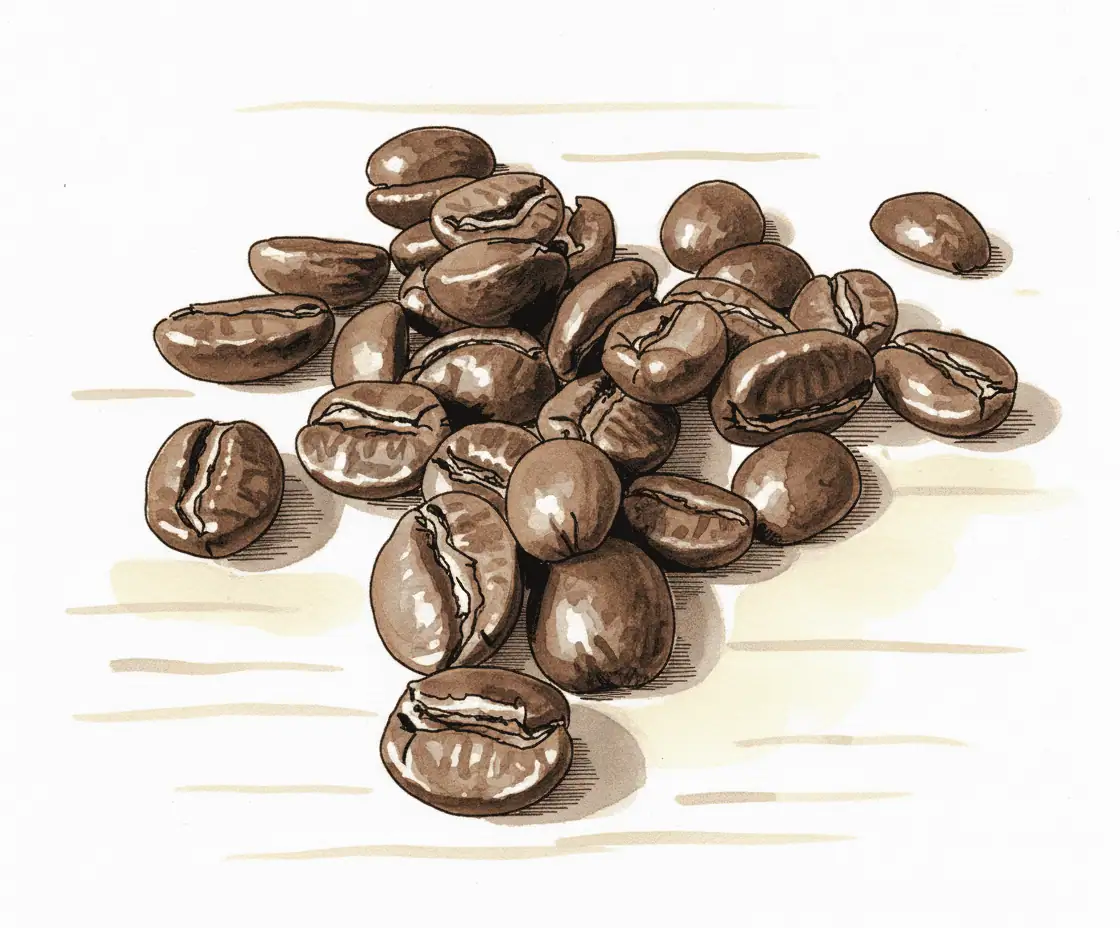Average altitude
Mid altitudes (around 1200–1500 meters) produce beans that offer a balance between sweetness and acidity. Growing conditions are still mild, yet the beans often develop more refinement than at lower elevations. This results in a brighter flavor profile, sometimes with subtle fruit or floral notes. Mid-altitude regions are common in countries such as Colombia, Mexico, and parts of Central America.
Beans

Honduras Marcala Comsa
COMSA is een coöperatie uit Marcala, Honduras, waar Arabica op vulkanische bodems tussen 1 200 en 1 600 meter groeit. De regio heeft een beschermde oorsprongsbenaming voor koffie. Brandzaak brandt deze bonen dagelijks vers en beoordeelt ze met een SCA score van 83,5, specialtykwaliteit. Het profiel is vol en romig met tonen van melkchocolade, walnoot…

Huehuetenango
Deze gids verkent Huehuetenango koffie uit het westen van Guatemala, waar kleinschalige Q’anjob’al en andere inheemse producenten op hoogtes van 1400 tot 2200 meter werken. De regio levert specialty bonen met medium tot medium dark roasts, vaak met karamel, melkchocolade, abrikoos en citrus, soms kers en notige tonen. De verwerking is doorgaans gewassen met zondrogen,…

Huis Melange Mild
Deze milde huisblend combineert bonen uit Brazilië Colombia Tanzania en Indonesië, afkomstig uit regio’s als Minas Gerais Huila Kilimanjaro en Java, geoogst op 600 tot 1800 meter, langzaam gebrand voor balans en body, met aroma van bittere cacao geroosterde noten en frisse citrus, mild en romig zonder harde bitterheid, variëteiten zoals Yellow Catuai Caturra Castillo…

India
Specialty coffee from India grown by farmers personally known, cultivated at altitudes of 800 to 1800 meters, with screen size 14 to 18 and an SCA score of 84, medium roast for balance between body and acidity, fresh aroma without over-roasting, flavors of milk chocolate, roasted hazelnut, and tamarind with a spicy accent, processed through the washed method for clarity...

India Karadykan Estate
India Karadykan Estate is een veelzijdige specialty koffie uit de Baba Budangiri heuvels in Karnataka. Op circa 1200 meter groeit Arabica naast peper en vijg, met een historisch waterwiel voor duurzame energie. De brand is licht tot medium en werkt zowel als filter als espresso. Verwacht smaken van zwarte kers, pruim en pure chocolade, met…

India Karadykan Estate Anaerobic Koffiebonen
India Karadykan Estate Anaerobic is een single origin Arabica van 1200 meter in Baba Budangiri. De Catimor variëteit groeit tussen kokos, peper en kardemom en wordt natuurlijk gefermenteerd in een afgesloten omgeving, wat zorgt voor intense fruitige tonen. Verwacht kers, pruim en pure chocolade met een complexe, rijke aromatiek. Wekelijks vers gebrand in Rotterdam West,…

India Monsooned Malabar AA Aspinwall
India Monsooned Malabar AA Aspinwall komt van de Malabarkust in Zuid India op hoogtes van 1000 tot 1200 meter, de bonen worden drie tot vier maanden gemonsoond waardoor de zuurgraad daalt en de body voller wordt, met kruidige zoete en hartige tonen van speculaas karamel chocolade en noten, het profiel is meestal medium roast met…

India Monsooned Malabar Coffee Beans
India Monsooned Malabar van Evermore is een honderd procent Arabica uit de Zuid-Indiase heuvels. De bonen ondergaan een monsooning-proces van twaalf tot zestien weken, waardoor ze zwellen, bleekgoud kleuren en hun zuurgraad verliezen. Evermore brandt wekelijks in Rotterdam West, meestal medium tot city roast, om aardse, kruidige en cacaotonen te laten spreken. Het resultaat is…

Indonesia Sumatra
Deze Sumatra Aceh koffie komt uit de hooglanden op 1100 tot 1500 meter. De bonen rijpen langzaam in een vochtig microklimaat. Verwerking en selectie gebeuren bij het familiebedrijf PT Raja Putra Manggala in Medan. De koffie is biologisch gecertificeerd. Brandzaak brandt medium roast op ambachtelijke wijze en levert dagelijks vers. Het profiel biedt een volle…

Indonesie • Trenggiling
De Indonesische Trenggiling komt uit Sumatra Atjeh op 1200 tot 1700 meter. Het betreft 100 procent Arabica met variëteiten Andung Sari Ateng Linie S-795 Jember Timtim en Typica. Verwerkt met wet hulling, wat zorgt voor een vol, aards en kruidig profiel met tonen van donkere chocolade. Friszoet en fruitig met blauwe bes en appel, plus…

Indonesië Sumatra Mandheling, freshly roasted, 1000 grams
Deze Sumatra Mandheling komt uit Aceh in Noord Sumatra. De koffie groeit op 1200 tot 1500 meter, wat zorgt voor langzame rijping en rijke aroma’s. De bonen worden traditioneel verwerkt met giling basah, waardoor de zuurgraad laag blijft en de body vol en siroopachtig is. De roast is medium dark met een Tonino score van…

Italian Stallion
Italian Stallion is een espressoblend met 80 procent Arabica en 20 procent Robusta uit Brazilië, Oeganda en Thailand. De bonen groeien op 1 250 tot 2 100 meter en worden gewassen verwerkt voor helderheid. De branding is net donkerder dan medium, met een romige body, balans tussen zoet en bitter en een afdronk van donkere…

Janson X-527
Janson X 527 is een single origin Green Tip Geisha uit Volcan Panama, geteeld door de familie Janson op 1350 meter. Manhattan Coffee Roasters brandt deze koffie in Europa binnen de World Class serie, met filter en espresso profielen. De smaak is delicaat en bloemig met zwarte bes, violet en witte roos en een zijdezachte…

Java
Deze Java Arabica Typica van De Pelikaan komt uit Sulawesi Toraja, op 800 tot 1.350 meter. De koffie is halfgewassen, onder dak gedroogd en met de hand geplukt, wat zorgt voor een volle body en een zachte afdronk. Verwacht tonen van vanille en noten, met lage zuurgraad, ideaal voor filter en espresso. Verkrijgbaar als bonen…

Jouster Melange
Jouster Melange is een medium donker gebrande blend met bonen uit Nicaragua Colombia en India. De melange biedt tonen van donkere chocolade hazelnoot en een vleugje fudge, met volle body een romig mondgevoel en lage zuurgraad. Alle componenten zijn gewassen verwerkt voor een schone en consistente smaak. Het is de bestverkochte melange van Op Kop…

Jukia Park
Jukia Park is een single origin koffie uit Uganda, geproduceerd door Lucy Agenpanga in samenwerking met kleinschalige boeren rond Zombo. De bonen ondergaan een 48 uur durende anaerobe natural fermentatie, wat de fruitige complexiteit en zoetheid versterkt. De lichte roast, gebrand op een energiezuinige Loring in Utrecht door Keen Coffee, legt tonen bloot van bruine…
Mid-Altitudes (around 1200–1500 meters)
Looking for a beautiful balance between sweetness and acidity in the cup? Then beans from mid-altitude regions are a great choice. These areas are common in countries like Colombia, Mexico, and parts of Central America. Here you get the best of both worlds: enough coolness for a refined taste, yet enough warmth for good sugar development.
How altitude affects espresso flavor
At elevations of roughly 1200 to 1500 meters, coffee cherries still ripen more slowly than at sea level, but not as slowly as at very high altitudes. This creates a balanced espresso: a mildly sweet base, often with subtle fruity or floral hints, alongside a pleasant, not overly dominant acidity. These coffees are known for their approachable yet refined character. They are often ideal for those who enjoy an espresso with a clear flavor, but without the sometimes “sharp” edge of very high-grown beans.
Chemical composition: balance of sugars and acids
Mid altitudes still give the coffee plant enough coolness to build complexity, yet enough warmth to encourage sweeter notes. The beans generally have a slightly lower density than true high-grown beans, but remain firm enough to develop a wide flavor palette. You will notice the acids are a touch less pronounced, allowing the sweetness to come forward. This can yield a balanced cup of espresso with both freshness and a soft body.
Processing methods: diversity is key
In many regions at these elevations, there is active experimentation with different processing methods. The washed method remains popular, but honey and semi-washed processes are also often used, depending on local traditions and the desired flavor profiles. Thanks to slightly higher temperatures (compared to high mountains), sun-drying beans is often easier. This allows farmers to apply natural or pulped natural methods, which in turn leads to more sweetness and sometimes a hint of fermentation in the taste.
Climate and microclimate
At 1,200 to 1,500 meters, conditions usually mean mild temperatures, regular rainfall, and still plenty of sun. This kind of environment is ideal for coffee shrubs. They are protected from extreme heat, but also from the cold of great heights. As a result, the growing season is stable and fairly predictable. Microclimates arise from local variations in rainfall and hours of sunshine. A shrub on one mountainside can therefore produce slightly different flavor nuances than one on the slope next to it.
Yield and resilience
In general, the yield here is better than at very high elevations, because the plants are less stressed by colder nights or thin air. This means farmers can often produce slightly higher volumes while quality remains high. Moreover, the shrubs can often stay healthy for longer, provided they are well maintained. A stable yield is beneficial for the local community, as farmers’ income is less dependent on erratic harvests.
Choosing coffee varieties
In this altitude band, many Arabica varieties are found, such as Caturra, Colombia, and Bourbon. Farmers often choose plants that strike a good balance between yield and flavor. Some varieties are resistant to diseases like "coffee leaf rust", which is an important factor in areas with higher humidity. This allows farmers to grow with confidence, knowing they will harvest consistently tasty coffee.
Coffee from mid-altitudes is therefore highly recommended for anyone seeking a balanced espresso. Expect subtle fruit or floral notes, complemented by a mildly sweet body. No sharp extremes, but a rich, approachable flavor that many drinkers appreciate.
A selection for those who are open to a lively and complex coffee experience.
